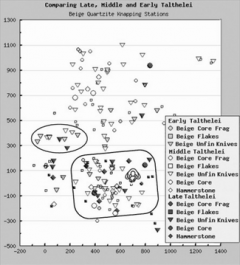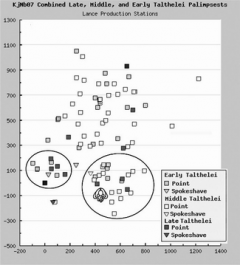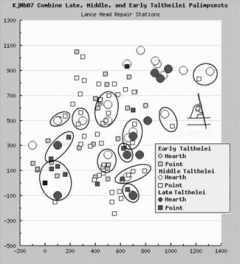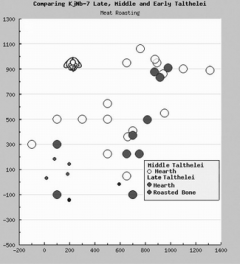
Figure 2. KjNb-7 Site Plan, Profile and Palimpsest
The KjNb-7 overlook is not large, with some forty 2-m squares excavated (Fig. 2, top left). The 50-cm contour intervals reveal a comparatively flat surface and levels, ideal for a dozen or so people doing many tasks while awaiting the herd. The upper three cultural levels are clearly separate in east-west and north-south profiles, the uppermost thin level 1 being combined with level 2 for analysis (Fig. 2, bottom). The bottommost Arctic Small Tool and Shield Archaic levels can be ignored because they represent different cultures. The youngest bone-rich Late Taltheilei level overlies the archaeologically richest Middle Taltheilei level, which is above the slightly discontinuous Early Taltheilei level. KjNb-7’s small size is deceptive, but it has the densest artifact concentration of all Barrenland sites.
I believe these findings show repeated tasks in a confined space of one culture and one caribou
herd for thousands of years by making it possible to compare single tasks within the combined palimpsests. Fig. 2 (top right), showing artifacts from all tasks, was made amenable to analysis by separating each task. It is about the same scale as the site plan (top left), with the densest part of the combined palimpsests in squares 35, 36 and 43 east of the main site datum (0,0 target in site plan). Ethnohistoric data suggest stone knapping was a male task, so representative icons (over-scaled in these reduced graphs) were oriented beside the clusters (Figs. 3, 4). In the single palimpsests, I rotated, scaled and sexed icons (male shoulder width 45 cm; women 38 cm) by artifact distribution and right and left-handedness (ratio 5:1 like modern humans), with hammerstones right or left accordingly.
First I plotted the dominant hues of beige, orange, white, brown and pink cores, flakes and unfinished knives in the combined palimpsests. Middle phase symbols are unfilled because they dominate and would obscure the other phases, while the fewer Late and Early symbols have dark or light gray fills. Hue was important only in stone knapping but it had the most artifacts, greatly clarifying the other tasks when they were removed from the palimpsest. Fig. 3a has heavily used beige knapping stations in its southeast part, the dearth of hammerstones elsewhere suggesting they were removed for breaking marrow bones elsewhere. The north half has only one Late phase core and two knives, one under a Middle core fragment, plus a few Early artifacts, but most are scattered Middle phase artifacts. A small cluster of beige knife fragments of all phases is in the west-central part.

Figure 3a. LT, MT, ET Beige Quartzite
Fig. 3b of orange quartzite also has intense southeast knapping but no appreciable southwest cluster. It has scattered Middle phase cores and fragments, and unfinished knives, but its small western cluster has two Late hammerstones and Early knives and flakes.

Figure 3b. LT, MT, ET Orange Quartzite
Fig. 3c shows a similar pattern to the last figure but in white quartzite, and with no appreciable western cluster.

Figure 3c. LT, MT, ET White Quartzite
Fig. 3d of brown quartzite closely resembles 3c, with scattered Middle phase cores, flakes and unfinished knives.

Figure 3d. LT, MT, ET Brown Quartzite
Lastly, Fig. 3e of pink quartzite resembles the others, except there is no appreciable task to the north. For almost three millennia, heavy use of five hues in the south part of KjNb-7 may be explained by most river cobble cores being these same hues, their location further from the river allowing more concealment from the approaching herd.

Figure 3e. LT, MT, ET Pink Quartzite
The second sequential task was lancing caribou when crossing the river. Fig. 3f represents the preparation of lances and their heads for all phases, including spokeshaves for rounding wooden shafts. Lanceheads were chipped from large quartzite flakes and edge-retouched with antler tine billets. The billets and the shafts have long since deteriorated. Fig. 3f shows new, full lanceheads with the base of the head ground to protect the lashing sinew, their distribution more even than the knapping stations, but with the usual dense southern clusters. Although lancing was popular in Late phase and common in Early phase, Middle phase lanceheads predominate: Late Taltheilei has 13 full lanceheads, Early phase 22, while Middle phase has 47.

Figure 3f. LT, MT, ET Lancehead Making
Associated with lance production was lancehead repair (Fig. 4a). Late Taltheilei has 14 broken lanceheads (mainly broken-off bases), while Middle and Early phases have 43 and 22. Lancing caribou in the river involved periodic breakage on river cobbles and solid bone, resulting in lances with broken bases being returned to camp for head replacement. This explains why broken lanceheads are almost all bases near hearths (circles), where they were discarded after water and heat were used to loosen their blood-glued sinew binding. Hearths without bases in the northeast were used in meat roasting and marrow extraction and appear under these tasks. Phase-specific hearths and their broken lanceheads are well distributed, although bases discarded far from their hearth are unassignable.

Figure 4a. LT, MT, ET Lancehead Repair
As the third task was butchering, I looked for worn knives used by women to cut meat from long bones to slice thin for drying (Fig. 4b). Drying was done quickly to prevent spoilage, so bones were set aside for later fragmenting and marrow extraction, while hides were temporarily wind dried. The intense activity in 4b shows butchering and meat-drying were major tasks in KjNb-7 after quartzite knapping. Sliced meat was placed on hide before drying on nearby bushes or frames, so space was adequate in separate palimpsests.

Figure 4b. LT, MT, ET Butchering
The fourth task was quick roasting and immediate consumption of brains and meat from the cranium, ribs, scapula, pelvi, vertebra and ankles (Fig. 4c). The few roasted bones shown compared to the many hearths was due to our fast removal of thick bone pavements in the short arctic summer field season. The best that we could do was place the bone pavement into level bags, one for each level in a 2-m square, and weigh them. Ideally, all bones should be plotted, but we had time only for plotting representative or easily identified bone. Those shown in the southwest are from my original test-pit.

Figure 4c. LT, MT, ET Meat Roasting
The fifth task of marrow extraction is also hearth-related (Fig. 4d). Again, the few in the southwest are from my original test-pit. Marrow is mostly fat, the most concentrated easily stored energy source, especially for transport south for winter. It is also needed to reach the minimum of 18% body fat content needed to bring a fetus to full term (e.g., Frisch, 1988; Rosetta, 1992), which could be difficult to achieve in some, if not many years, due to seasonal restrictions in herd follower diet. Bone breaking and marrow extraction were female tasks. Marrow exists in ribs, vertebra and ankle bones, but long bones produce the best quality fat (Jenness, 1922:102-3; Wilson, 1924:174). They were crushed on a hide so fragments were not lost or soiled, and quickly transferred to boiling water. So I looked for hearths, unburnt long bone fragments, fire-cracked rock or boiling stones and enough space for the boiling operation. This was done in a birch bark vessel or sand depression lined with rawhide and filled with water. Space for these is excluded in these combined palimpsests, but the female icon is scaled. She is shown with a forked stick in her right hand for moving hot rocks from the fire to the water for boiling. Floating grease was

Figure 4d. LT, MT, ET Grease Extraction
removed with a muskox (Ovibos moschatus) horn or bark or wood skimmer, to be mixed later with dried meat powder and stored as pemmican. As the water filled with extracted long bone and fire-cracked rock, bone and fragmented rock were deposited further right while intact rock was returned to the fire for reheating. In my single palimpsests from each of the three levels, marrow extraction was rarely east of a hearth because the dominant west wind would scatter ash and cinders into the floating grease, rendering it inedible. There is also a limit to the amount of smoke one might tolerate.
The sixth task was hide preparation, and I plotted used chithos, scrapers and flexers (Fig. 4e). Chithos are thin, rough sandstone disks, while flexers resemble worn bifacial scrapers. Both were used to soften and stretch hides by dragging them over the outstretched hide from its center to its periphery like a huge scraper. Hence, the loss of these tools around the arc made by the hide, and their subsequent finding by us centuries later when we penetrated the wind-blown sand covering the palimpsest. When I plotted palimpsests individually, I set a 60-120° minimum arc of scrapers and chithos to orient a 1×2-m ovoid outstretched hide, adding a female icon opposite the artifact arc for scale.

Figure 4e. LT, MT, ET Hide Preparation
As my final task was woodworking, I included denticulates, wedges, pushplanes and spokeshaves used to cut, split, plane and round spruce poles and tool handles (Fig. 4f). These widely distributed tools were likely used on larger wooden objects requiring room to work.

Figure 4f. LT, MT, ET Woodworking
Conclusions
Tasks included quartzite knapping, lancehead manufacture and repair, butchering and meat-drying, roasting and the working of hides and wood. While caribou herd behavior directly influences choice of water-crossings and hence, hunting camps, Chipewyan hunting band behavior was also repetitive in the sequence of tasks carried out by ancestral Chipewyan for the past three thousand years.
Repetitive caribou herd and Chipewyan band behavior and range reconstruction is of interest to archeologists and biologists because it enhances the study of ancient human and Rangifer behavior in a world where animals exerted fundamental control over cultural expression. The presence of these palimpsests also indicates to caribou biologists that the same general seasonal pattern of migration by caribou on this range has been in place for thousands of years and gives support for the persistence of an overall fixed but annually flexible pattern of traditional migratory behavior over time, even under changing environmental conditions.
After deciphering each of the palimpsests into gender-based tasks in two earlier papers (Gordon, In Press, a, b), I combined all to show continued use of the same spots for all tasks for many centuries. Why is this? Certainly, the knoll where the KjNb-7 overlook is located, is small, wind-swept for insect control, and ideal for spotting caribou. But other factors were at work, and were likely social – perhaps some form of assembly line where intense butchering, meat-drying and hide-preparation for winter, allowed women to communicate and relieve the tedium. Bear in mind that fresh meat must be processed quickly for preservation, but also for a reasonably fast departure in following the track of the herd south for winter. Mothers may have taught their daughters those skills needed in marriage, while men did the same for their sons in hunting. Knapping stations were where men could hone and teach their skills. With more palimpsest deciphering in our other sites, perhaps we will find more answers on a sociological level.
Acknowledgments
I thank Raymond Cheng for selecting and customizing the software and teaching students and volunteers how to use it; Elizabeth Creary for formulating queries; Lori Howey and Elizabeth for plotting overlay tasks, artwork and editing; and Pavel Dvorak for final artwork and assembly. I am endebted to Frank Miller for his revisions and Frank Bayerl for a final edit .
References
Frisch, R.E. 1988. Fatness and fertility. Scientific American 258(3): 88-95.
Gordon, Bryan C. 1975. Of Men and Herds in Barrenland Prehistory. Mercury Series no. 28, Archaeological Survey of Canada, National Museum of Man, Ottawa, 535 pp.
______. 1996. People of Sunlight; People of Starlight – Barrenland Archaeology in the Northwest Territories of Canada. Archaeological Survey of Canada, [Mercury Series 154]Canadian Museum of Civilization.
______. 1988. Of Men and Reindeer Herds in French Magdalenian Prehistory. British Archaeological Reports, International Series 390, Oxford, England, 233 pp.
______. 2005. 8000 Years of Caribou and Human Seasonal Migration in the Canadian Barrenlands. Rangifer, Special Issue No. 16: 1-8.
______. In Press, a. Deciphering Archaeological Palimpsests – An Example from a Canadian Barrenland Rangifer Hunting Camp. Proceedings of the Meso2005 Archaeological Conference, Queen’s University, Belfast, Ireland. Oxbow Press (in press).
______. In Press, b. Palimpsest Deciphering: An Example from a Canadian Barrenland Early Talthelei Phase Hunting Camp. Festschrift for James Wright, Archaeological Survey of Canada, Canadian Museum of Civilization, Ottawa (in press).
Hearne, Samuel. 1958. A Journey from Prince of Wales’s Fort in Hudson’s Bay to the Northern Ocean 1769, 1770, 1771, 1772 (ed. by R. Glover). Reprinted Toronto: Macmillan 1958.
Jenness, Diamond. 1922. The Life of the Copper Eskimos. Report of the Canadian Arctic Expedition 1913-1918. F. A. Acland, King’s Printer, Ottawa.
Wilson, G.L. 1924. The Horse and the Dog in Hidatsa Culture History. American Museum of Natural History, Vol. 15, New York.
Rosetta, L. 1992. The relation between chronic malnutrition and fertility. Collegium Anthropologicum 1: 83-88. University of Zagreb, Zagreb, Croatia.